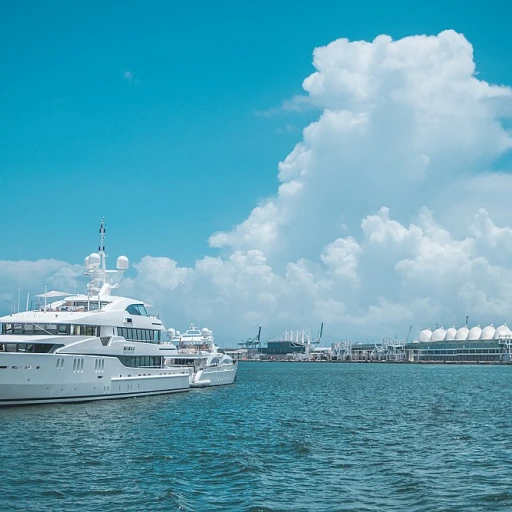-large-teaser.webp)
The Historical Significance of Nautical Flags
The Legacy of Nautical Flags
Nautical flags, with their vintage charm and black-and-white dramatic signals, have been a cornerstone of maritime communication for centuries. The use of flags to convey information on the high seas dates back to a time when semaphore flags were indispensable tools for maintaining order and safety. In the bustling hubs of the maritime world, such as ports and harbors, these flags were not just mere signals; they were vital components of a phoenetic alphabet code, ensuring that communication transcended language barriers.
Historically, these signal flags served to communicate a wide array of messages. Whether integrating into an international code or signaling a dramatic emergency at sea, they have played quintessential roles in vessel communication. Ships relied on the ics alphabet flags for directions, warnings, and to communicate tactical maneuvers. A flag hoisted aloft could mean anything from 'keep clear' to alerting nearby vessels of a course or direction change, transforming these mere pieces of cloth into powerful maritime tools.
In today's digital age, one might presume that such manual forms of communication have become archaic. While technological advances certainly influence modern yachting practices, the historical significance of these flags remains undisputed. They are emblems of the rich maritime history, serving as cultural relics that remind yachting enthusiasts of the seafaring adventures of yore. The mechanics of their communication, laid out in the systematic alphabet and signal code, continue to fascinate both seasoned sailors and newcomers alike.
For yachting aficionados, understanding these historical facets is as crucial as grasping the modern-day intricacies of anchor drive systems and their influence on nautical navigation.
Understanding the Nautical Flags Alphabet
Decoding the Nautical Flags Language
The nautical flags alphabet plays a pivotal role in maritime communication. Each flag represents a specific letter or concept, forming a comprehensive "alphabet" of signals utilized by vessels across the globe. This intricate system stems from the International Code of Signals (ICS), a universally recognized code enabling ships to convey critical information efficiently. The ICS assigns each letter of the English alphabet to a distinct flag, designed with vibrant colors and geometric patterns. A practical yet dramatic visual language emerges, allowing vessels to communicate even in challenging conditions. The flags themselves can indicate a single letter or be combined to form words and messages. Their usage extends beyond linguistic interpretation, as each letter is paired with specific code signals, enhancing the clarity of conveyed messages. Moreover, the nautical signal flags are not limited to letters alone. They encapsulate important phrases such as "keep clear" or "altering course," offering substitute communication methods in high-stakes maritime scenarios. If a crew member recognizes a ship flying a black flag nautical signal, it indicates a vessel experiencing technical difficulties or signaling distress, underscoring the life-saving potential of these signals. To truly master the nautical flags alphabet, one must understand the unique symbols and phonetic alphabet associated with each flag signal. This knowledge not only ensures effective communication on the water but also enriches your yachting experience with an authentic touch of maritime tradition. There is great value in unlocking this vintage code's language, granting a deeper connection to its historical roots and practical applications today. For those interested in further delving into the art and practice of nautical signal flags, it is worthwhile to explore various boat accessories that complement and enhance your yacht experience. These entertaining additions contribute a sense of personalization and utility when integrated alongside your growing understanding of the nautical flags alphabet. For more inspiration on yacht enhancements, explore these entertaining boat accessories.Practical Applications in Modern Yachting
Nautical Signals in Today's Yachting World
In the realm of modern yachting, nautical flags play an indispensable role by facilitating precise communication. Yachts traversing vast oceans and intricate waterways rely on the enduring principles of these signal flags, which have steadily held significant relevance despite technological advances over the years. The international code of signals provides a standardized language that transcends the barriers of spoken dialects, allowing vessels from different nations to interact seamlessly. Whether navigating in congested waters or signaling distress during adverse conditions, the clarity that nautical flags provide is crucial. Additionally, the alphabet flags are invaluable tools for providing real-time information, aiding in operations, and ensuring safety when emergencies arise. While modern technology may offer alternative communication methods, the reliability and simplicity of these flags endow yachts with an extra layer of security. Yachting professionals have also developed a keen understanding of the dramatic visual impact these flags create, enhancing the grandeur and aesthetics of a vessel. The combination of vibrant colors and vintage designs stands out, allowing yachts to convey messages that are both functional and visually striking. For those who wish to deepen their understanding of these communications, learning and mastering the nautical flags alphabet is essential. This ensures that all those onboard are equipped to effectively use this traditional yet vital maritime signal system. Whether it’s deploying a signal flag to indicate 'keep clear,' or altering course, proficiency remains a vital asset. For yacht owners eager to maximize their on-water experience, exploring roles in yacht stewardship can also widen your nautical prowess, providing further insights into how these traditional systems integrate with modern yachting operations. Check out more on steward roles for advanced sailing knowledge and to ensure smooth operations aboard.The Role of Nautical Flags in Yacht Racing
Nautical Flags in Competitive Waters
In the high-stakes environment of yacht racing, where strategy and precision determine success, nautical flag signals play a vital role. Racing rules, meticulously followed by all, are often communicated through a complex system of flag signals. This ensures clarity and safety among competing vessels, essential when navigating tight and competitive waters. Nautical flags serve as a real-time communication tool. Racing vessels employ these flags for many purposes, such as starting procedures, recalling premature starters, or altering course. Each signal is part of the international code, a standardized system ensuring uniformity across international waters. Understanding these signals can make the difference between victory and a costly penalty. The use of traditional nautical flags in racing reflects the industry's reverence for maritime tradition and heritage, while simultaneously embodying a dramatic modernity. Despite technological advances, including digital communication devices, these vintage methods maintain their importance due to their simplicity and reliability in varying conditions. Interestingly, the integrity of flag signals is bolstered by their adherence to the international system. This ensures that regardless of the origin of participants, the communication remains consistent and free from errors, much like a universal maritime language. Instead of relying on verbal communication, which may be hindered by the elements, the visual alphabet provided by flags ensures that all vessels within sight can interpret the signals swiftly and accurately. The art of effectively using nautical flags is not only restricted to skilled sailors and race officials; it’s also imperative for the onshore team to understand these signals well. Their significance extends beyond the racecourse, emphasizing the timeless role of flag signals in managing course alterations, safety protocols, and ensuring a smooth sailing experience in competitive yachting.Technological Advances and Nautical Flags
Modern Innovations and Technological Tandem
The world of nautical flags, though vintage in its charm, has gracefully sailed into the modern era with a touch of technology. These international signal flags have, for centuries, transcended their role as mere identifiers on the high seas. As we explored earlier, they've remained steadfast symbols of maritime communication. In today's age, technology has gifted us with digital solutions and innovations, yet the practical use of alphabet flags continues to bridge the gap between tradition and modernity.- Technological Integration in Navigation Systems: With advancements in maritime technology, many modern vessels are equipped with touch-screen interfaces and digital dashboards. These systems often include digital representations of the nautical flags alphabet, allowing captains to reference the traditional signals while easily accessing international code counterparts in their navigation systems.
- Enhanced Signaling through Lighting: Navigational lighting systems can enhance or substitute flag signals when visibility is limited under dramatic maritime conditions. This integration ensures that older vessels or vintage sailboats still adhere to signaling standards, promoting safer maritime operations.
- Wi-Fi and Satellite Connectivity: On most luxury yachts, Wi-Fi and satellite connectivity allow real-time updates of vessel positions and signal translations. While the flags flutter in the wind, complementary digital systems provide automatically translated readouts of the flag signals, ensuring clarity when communication might be impeded by environmental factors.













